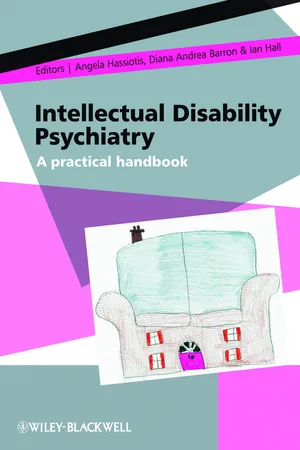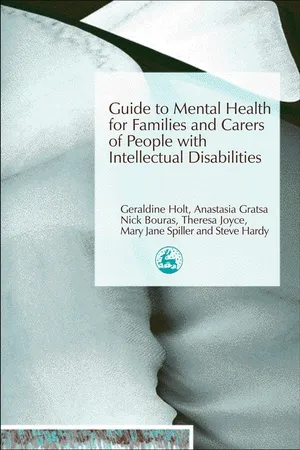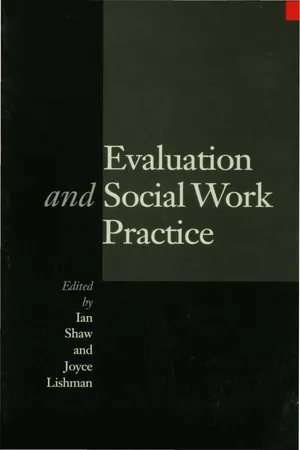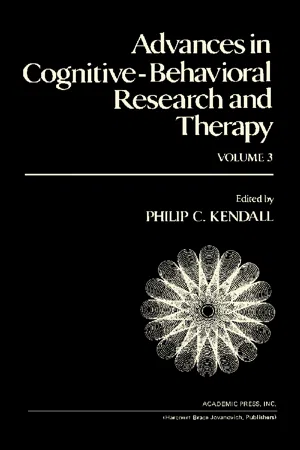Psychology
Behavioural Interventions
Behavioural interventions are therapeutic techniques used to modify or change specific behaviors. These interventions are based on the principles of behaviorism and focus on observable actions and their consequences. They are often used to address a wide range of psychological and behavioral issues, such as phobias, addictions, and disruptive behaviors.
Written by Perlego with AI-assistance
Related key terms
1 of 5
8 Key excerpts on "Behavioural Interventions"
- No longer available |Learn more
- Philip Banyard, Christine Norman, Gayle Dillon, Belinda Winder, Philip Banyard, Christine Norman, Gayle Dillon, Belinda Winder(Authors)
- 2019(Publication Date)
- SAGE Publications Ltd(Publisher)
Some early explanations of mental disorders focused on biological explanations, asserting that there was some sort of disease of the brain, and other explanations focused on the supernatural, such as demons or possession (see Figure 25.1). The exact nature and purpose of psychological interventions continue to be under debate and interventions have fallen in and out of fashion, with the approach taken chang- ing depending on the underlying theoretical model. However, all interventions should use accepted psychological methods and are ‘broadly based on the use of the interac- tion between therapist and service user to elicit changes in the service user’s behaviour (for example, drug use), as well as other related factors, including cognition and emotion’ (National Institute of Clinical Excellence (NICE), 2008). In the literature, the term ‘psychosocial intervention’ is also widely used. This is a broader term than psychologi- cal intervention and refers to any intervention that empha- sises psychological or social factors rather than biological factors (Ruddy & House, 2005). It therefore includes psychological interventions, but also includes educational programmes and social assistance, for example, parenting classes. For more information, see Video 25.1 on the website. 25.2.1 Delivering psychological intervention Psychological interventions have a broad scope and work on a huge range of psychopathologies, difficulties and behaviours. There are many different types of cli- ent for psychological interventions and they come from a range of sources. The one you may be most familiar with are people diagnosed with a mental health issue (e.g. depression or schizophrenia) who are referred to therapy. However, psychologists also work with people who have decided to seek help for an issue with how they think or behave or are referred because their behaviour is harmful to themselves or others (e.g. self-harm or crim- inal behaviour). - eBook - PDF
- Susan Bailey, Mairead Dolan(Authors)
- 2004(Publication Date)
- CRC Press(Publisher)
For example, behavioural 266 Cognitive–behavioural therapies approaches to depression help the individual to structure a daily routine in an effort to trigger behaviours that will be positively reinforced (Fennell 1989). Rewards for achieving specific behavioural targets may take the form of approval, access to desired activities, or points or tokens which can be used to gain access to such activities or purchase material goods. Behavioural contracts may also be used, whereby the individual agrees to behave in certain ways and receives rewards for doing so (DeRisi and Butz 1975). Behavioural modification approaches have been used in the treatment of aggressive adolescents (Varley 1984), and in residential settings, where there is greater control over the environment (Cullen and Seddon 1981; Milan 1987). The term ‘behaviour therapy’ is also used, although use of this term tends to be restricted to individualized Behavioural Interventions focused on improving behav-ioural competence and performance – for example, help-ing someone to become less anxious by teaching them how to relax, or how to be more assertive by teaching assertiveness skills. Cognitive theory Although behavioural practitioners do not deny the existence of an inner psychological world of thought and feeling, there has been considerable debate about the influ-ence of these factors in determining behaviour (Blackman 1981). This debate has been central to the development of CBTs. Traditionally, many behavioural practitioners considered the inner psychological world to be less impor-tant than external events in determining behaviour, and therefore focused their interventions on external factors (Jones et al. 1977). Thus, whilst counselling a young male offender to help him to develop a positive self-image may be useful and desirable, it could be argued that a more powerful intervention would be to teach him social and personal skills that evoke positive responses from other people. - eBook - ePub
From Inclusion to Engagement
Helping Students Engage with Schooling through Policy and Practice
- Paul Cooper, Barbara Jacobs(Authors)
- 2011(Publication Date)
- Wiley(Publisher)
4 Interventions for Enhancing Teachers’ Skills Overview In this chapter we examine a range of interventions designed to promote positive student engagement that can be employed by individual teachers in a school setting. Behavioural, cognitive behavioural and instructional strategies are explored. We review evidence for the efficacy of these approaches. Behavioural Interventions Behavioural approaches for dealing with SEBD are based on principles of contingency management and reinforcement that were developed initially on the basis of research with animals. It is to the work of Watson and Skinner that the widespread applications of behavioural theory to human subjects can be attributed (see Chapter 2). This history has sometimes led to behaviourism being attacked for its reductionist portrayal of humans as being on same behavioural plane as animals, and for its denial of the importance of ‘mind’ (e.g., Malik, 2000). Along with these views come concerns about the undeniable power of behavioural methods to shape and thus manipulate human behaviour. These are important criticisms that must not be ignored. Having said this, it is equally important to emphasize the way in which behavioural approaches require us to understand deviance in terms of objectively observable behaviour without reference to attitudinal or other personal factors (Cooper et al., 1994). Such an approach can, for example, have the positive effect of removing feelings of hurt or blame which may serve to exacerbate a problem and direct attention to aspects of the educational environment which may be influential as antecedents to or consequences of the behaviour in focus - eBook - ePub
Intellectual Disability Psychiatry
A Practical Handbook
- Angela Hassiotis, Diana Andrea Barron, Ian Hall, Diana Andrea Barron, Ian Hall(Authors)
- 2013(Publication Date)
- Wiley(Publisher)
With the gradual closure of long-stay institutions and an increased focus on community care, support to manage individuals’ moves into the community became a significant aspect of psychological work, as did an array of other activities aimed at increasing quality of life. Since the early 1990s there has been an increased focus on the emotional and mental health needs of people with intellectual disabilities and a steady development of therapeutic work. The role of psychology within intellectual disability services has expanded and diversified enormously as a result. Where, once, only behavioural approaches were on offer, in many services now a whole range of psychological interventions is available. These may be delivered either directly with the person with intellectual disabilities or through indirect work, such as with a staff team or the management of an organization, or a combination of both modes of delivery. Furthermore in line with their training as scientist-practitioners, psychologists have an important role in designing and completing research and service evaluation.All psychological interventions are (or certainly should be) based on a thorough assessment and formulation which pays close attention to the context of the person’s life and their presenting problems. Depending on the theoretical model guiding assessment, this may focus more on:- current emotional functioning and its roots in early development
- a detailed understanding of events
- cognitions and
- behavioural patterns in the here and now
- or relational issues.
The scientist-practitioner model underlying clinical psychology is guided by a formulation of the presenting problem which makes sense of the information gained during assessment and draws on psychological theory to provide an understanding how the problem developed and what factors may be maintaining it. This formulation will then guide the planning of any intervention and will be revised as additional or contradictory information emerges. Finally, the outcomes of any intervention should be assessed using valid and reliable methods.15.2 Frameworks for psychological work
Prior to considering psychological interventions in detail, it will be useful for the reader to be familiar with some broad frameworks which guide the practice of clinical psychologists. A prominent one notes that all psychological work with people with intellectual disabilities should be socially valid and person centred [3]. Thus it should address socially significant problems, in a manner acceptable to those involved and - eBook - PDF
Developments in Psychotherapy
Historical Perspectives
- Windy Dryden(Author)
- 1996(Publication Date)
- SAGE Publications Ltd(Publisher)
As a result, the nature of therapy involves the therapist in constant questioning and instruction of the client. In behaviour therapy, the relationship with the client is basic to all interventions, but does not, in itself, constitute an intervention. The client groups addressed by Behavioural Interventions are extremely diverse. Unlike traditional verbal psychotherapies, the scope to address different client difficulties is vast. Traditional therapies and counselling have typically concentrated on intelligent, verbally able people with compara-tively minor difficulties -the so-called YAVIS ( young, attractive, verbal, intelligent, successful ) criteria ( Eysenck, 199 1 ) , and have not strayed far into the territory of severe mental disorder. By contrast, behaviour therapy has, since its inception, concerned itself with the full range of human difficulties, including long-term mental health problems, learning disabili-ties and consequences of institutional care. Behavioural accounts of human experience and distress are now often regarded as oversimplifications, and modern cognitive theories appear more attractive to many therapists. However, the simpler learning theory accounts still play a considerable part in treatment. More than this, learning theory is now part of the general folklore of society, and people who have never heard of Pavlov and Skinner, and would possibly be appalled at some of the ideas of these early behaviourists, speak of 'conditioning ' and 'reinforcement ' in a natural and informal way. Behaviourism has become an accepted part of the way we all look at our daily lives. Early behavioural approaches If the language of behaviourism has filtered into our daily discourse, so there are suggestions that the techniques of behaviour therapy have always been part of lay understanding of our difficulties. - Anastasia Gratsa, Geraldine Holt, Nick Bouras(Authors)
- 2004(Publication Date)
- Jessica Kingsley Publishers(Publisher)
By thinking aloud the person can become aware of links between aspects of feelings and behaviour that previously have been unrecognized. The counsellor explains the rationale and that has the effect of making problems more understandable and therefore gives the person the confidence that he or she can solve the problems. The development of trust between the therapist and the person is important. It allows communication in words, and it promotes the understanding and integration of previously unacknowl-edged aspects of the self and relationships. Behavioural therapy Behavioural therapy suggests that apparent behaviour has been learnt. Behavioural therapy aims to identify and directly change unwanted behav-iours. Or, alternatively, unwanted behaviours are ignored whilst more positive socially valued behaviours are rewarded. Less attention is paid to what has actually caused these unwanted behaviours. WHO IS BEHAVIOURAL THERAPY FOR? This kind of therapy can be used with people who have limited or no verbal communication skills, although the ability to communicate one’s thoughts and feelings can give valuable information for behaviour therapy. Again in order to reach a successful result the person has to co-operate as much as possible with the intervention plan. WHAT HAPPENS IN BEHAVIOURAL THERAPY? Current behaviour management combines the teaching of new skills together with the suppression of undesirable behaviours. There are several ways of encouraging and increasing new behaviours. Some carers might THERAPEUTIC INTERVENTIONS / 131 have used these techniques at home over the years without even realizing. These techniques are widely used and include the following: · The ABC approach · Positive reinforcement · Prompting · Shaping · Chaining · Relaxation training · Role-playing · Modelling · Desensitization Some items on the list are briefly explained below, as they are particularly relevant to people with intellectual disabilities and mental health problems.- eBook - PDF
- Ian Shaw, Joyce Lishman, Ian Shaw, Joyce Lishman(Authors)
- 1999(Publication Date)
- SAGE Publications Ltd(Publisher)
13 BEHAVIOURAL AND COGNITIVE INTERVENTIONS Maurice Vanstone In recent years in the United Kingdom, Canada and many states in the USA, the cognitive-behavioural model has been at the forefront of evidence-based practice with people who persistently offend (Ross and Ross, 1995; Underdown, 1998; Vennard et al., 1997). It is a form of intervention that utilizes a collection of methods drawn from behav-ioural and cognitive psychology, such as social skills training, self-reinforcement and systematic desensitization (McGuire, 1995). What follows is a critical analysis of the implementation and evaluation of this approach in North America and the United Kingdom and its impact on the shape and structure of both policy and practice. This will be overlaid with an account of the prominent discourses associated with the approach and, given the degree to which research questions impact on the ideas behind official policy, also a critique of the approach in order to identify lessons for future research and practice. The central arguments will reflect agreement with the view that 'evaluation is in itself a critical and inseparable part of being an effective practitioner' (Roberts, 1995: 229), and promote the belief that the disjunction implied in the very use of the phrase 'research and practice' is symptomatic of a central problem of social work practice in this field -the dearth of examples of evidence-based practice. Accordingly a feature of the chapter will be an exposition of the concept of the social work practitioner as a social scientist. Such practi-tioners are informed by a theoretical knowledge base, supported by specialist researchers, and respond to the daily problems encountered by clients with a flexibi lity and sensitivity to needs, while simultane-ously contributing to the professional knowledge base. - eBook - PDF
- Philip C. Kendall(Author)
- 2013(Publication Date)
- Academic Press(Publisher)
The next section briefly examines cognitive-behavioral interventions with children in the educational domain. This review is meant to be illustrative rather than exhaustive, and interventions conducted in noneducational settings with relevance to educational issues are included. III. COGNITIVE-BEHAVIORAL INTERVENTIONS IN EDUCATION Cognitive-behavioral interventions with children can be traced to the work of the Soviet scientists, Luria (1961) and Vygotsky (1962), and their pioneering research on the developmental interaction of verbal and nonverbal behavior. Their work had major impact on Meichen-baum's (1977) development of self-instructional interventions with children. However, contemporary cognitive-behavioral work with children has gone beyond self-instruction training and now includes direct verbal instruction, modeling, reinforcement strategies, role-play and behavioral rehearsal, self-reinforcement, and feedback, as well as a variety of self-instructional strategies (Urbain & Kendall, 1980). As Hobbs, Moguin, Tyroller, and Lahey (1980) pointed out, independent of the strategy used cognitive-behavioral interventions with children 136 Andrew W. Meyers and Robert Cohen share at least one distinctive feature. Children attempt to learn and perform mediating responses or strategies for controlling their behavior under a variety of circumstances. In our examination of cognitive-behavioral interventions in educa-tion, we identified four target areas that have received significant re-search attention. These areas are attentional problems, aggression, problem-solving and prevention, and academic performance. A. Attentional Problems Attentional problems affect a broad range of normally functioning and clinically identified children. Child behavior problems with hy-pothesized attentional deficit components include impulsivity, under-achievement, learning disabilities and hyperactivity, and neurological impairment (Craighead et ai., 1978).
Index pages curate the most relevant extracts from our library of academic textbooks. They’ve been created using an in-house natural language model (NLM), each adding context and meaning to key research topics.







